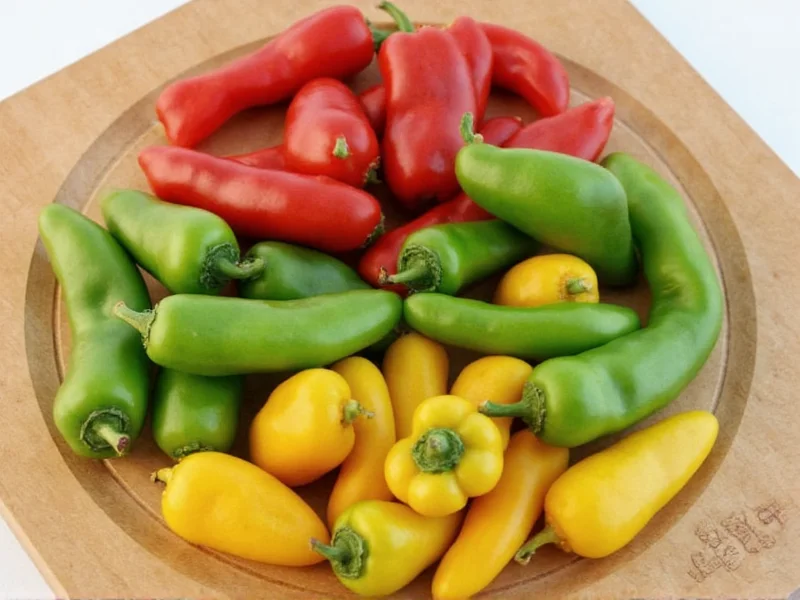Understanding the subtle differences between Fresno peppers and jalapeños is essential for home cooks and culinary professionals seeking precise heat levels in their dishes. While these two popular chili peppers appear similar at first glance, their heat profiles, flavor characteristics, and culinary applications reveal important distinctions that can make or break your recipe.
Scoville Scale Comparison: Understanding the Numbers
The Scoville scale measures chili pepper heat by determining capsaicin concentration. Both Fresno peppers and jalapeños fall into the medium-heat category, but their ranges differ slightly:
| Pepper Type | Scoville Heat Units (SHU) | Heat Level Classification | Typical Color When Harvested |
|---|---|---|---|
| Fresno pepper | 2,500-10,000 | Medium | Green (immature), Red (mature) |
| Jalapeño pepper | 2,500-8,000 | Medium | Green (immature), Red (mature) |
Notably, the heat range for both peppers depends significantly on growing conditions, maturity, and even individual pepper variation. A stressed plant produces hotter peppers, while well-watered, nutrient-rich plants yield milder fruit. The red varieties of both peppers generally pack more heat than their green counterparts.
Flavor Profiles Beyond Heat
While heat measurement is crucial, flavor complexity separates these peppers in culinary applications:
- Fresno peppers offer a fruitier, slightly smokier profile with berry-like notes, especially when red and mature. Their thinner walls make them excellent for pickling and blending into sauces.
- Jalapeños provide a brighter, grassier flavor with vegetal notes. Their thicker walls hold up better to stuffing and grilling.
Chefs working with authentic Mexican cuisine often prefer jalapeños for traditional salsas and preparations, while Fresnos have become popular in fusion cooking for their nuanced flavor profile. Understanding these flavor differences helps explain why simply substituting one for the other might alter your dish's character.
Culinary Applications and Substitution Guidelines
Knowing when to use each pepper can elevate your cooking:
Best Uses for Fresno Peppers
- Ideal for fresh salsas where a fruitier heat is desired
- Excellent in creamy sauces and aiolis (their thinner walls blend smoothly)
- Perfect for pickling due to their crisp texture
- Shines in seafood dishes where jalapeños might overpower
Best Uses for Jalapeños
- Traditional choice for pico de gallo and many Mexican salsas
- Superior for stuffing (like jalapeño poppers) thanks to thicker walls
- Ideal for roasting and charring for deeper flavor development
- Better for long-cooked dishes where sustained heat matters
Substitution Tips
When substituting between these peppers, consider these factors for successful results:
- For fresh applications: Use 1 Fresno pepper for every 1-1.5 jalapeños, depending on desired heat
- For cooked dishes: Jalapeños maintain heat better through cooking, so you may need slightly more Fresno to achieve equivalent heat
- When color matters: Red Fresnos provide similar visual appeal to red jalapeños but with slightly more heat potential
- For pickling: Fresnos generally yield crisper results than jalapeños
Growing Characteristics for Home Gardeners
Home growers should note these cultivation differences:
- Fresno plants typically grow 24-36 inches tall with peppers maturing in 70-80 days
- Jalapeño plants reach 24-30 inches with peppers maturing in 65-75 days
- Both require full sun and well-draining soil, but jalapeños tend to be slightly more disease-resistant
- Fresnos often produce more peppers per plant, but jalapeños typically have higher capsaicin consistency
Gardeners in cooler climates may find jalapeños slightly more reliable, while Fresnos thrive in warmer conditions. Remember that allowing either pepper to fully ripen to red increases both heat and sweetness.
Common Misconceptions About Pepper Heat
Several myths persist about comparing Fresno pepper Scoville ratings versus jalapeños:
- Myth: All red peppers are hotter than green ones
Reality: While generally true, individual growing conditions affect heat more than color alone - Myth: Fresnos are always hotter than jalapeños
Reality: There's significant overlap; a mature jalapeño can sometimes exceed a young Fresno - Myth: Seeds contain all the heat
Reality: The white pith (placenta) holds most capsaicin; seeds absorb heat from this tissue
Practical Handling Tips
Working safely with both peppers requires similar precautions:
- Always wear gloves when handling hot peppers, especially when cutting multiple peppers
- Never touch your face after handling peppers without thorough hand washing
- Remove seeds and white membranes for milder heat in both varieties
- Roasting either pepper can mellow the heat while enhancing flavor complexity
- When in doubt about heat level, start with less pepper and add more gradually
Professional chefs often test a small piece of pepper before committing to a recipe—this simple step prevents ruined dishes and disappointed diners. Remember that heat perception varies significantly between individuals, so what seems mild to one person might be hot to another.











 浙公网安备
33010002000092号
浙公网安备
33010002000092号 浙B2-20120091-4
浙B2-20120091-4